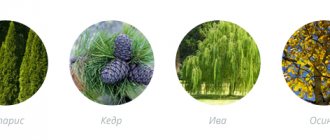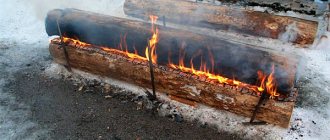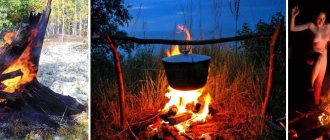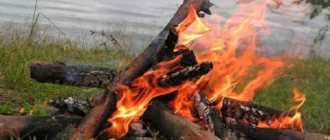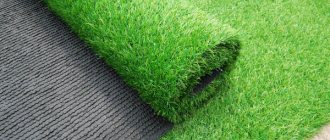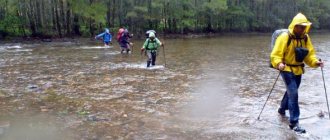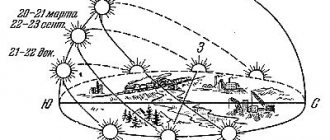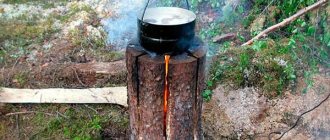Choosing a place for a fire is not a difficult task, but it is always mandatory. An incorrectly chosen place for a fire in some cases can simply cause inconvenience, for example, smoke flying towards the overnight stay is unlikely to provide a comfortable sleep, and in others it threatens the traveler with big problems, for example, a forest fire.
The almost optimal place for a fire is not far from the water, among the stones, at a distance from a young pine forest.
In this article, we will look at the basic rules for choosing a place for a fire for different conditions, for example, deep snow, swampy areas, as well as options for organizing a fire in unfavorable weather.
Basic rules for choosing a place for a fire
Following simple rules will allow you to avoid many of the troubles associated with starting a fire in a camp outdoors.
These rules include the following:
- You cannot burn a fire under trees. If the tree is dry, it may catch fire, and if it is alive, its roots may be damaged. Usually, to comply with this rule, it is enough to light a fire at a distance of 5 meters from the tree trunk or more. But in rare cases, this rule can be neglected, for example, if in a war zone it is necessary to hide a fire from a flying enemy aircraft.
- Do not light a fire near thickets of dry grass and bushes. Even a small spark flying from the fire can be enough to start a fire.
- You cannot make a fire in the thickets of young pine trees. This, by the way, is one of the rules prescribed by law.
- You cannot make a fire on peat bogs, because peat is a good flammable material that can easily be set on fire and smolder for a long time, emitting acrid smoke. If an urgent need arises, you can also burn on peat bogs, having first poured a thick layer of sand on the site of the future fire, but this is also unsafe. Among other things, failure to comply with this rule may result in administrative penalties in the form of a fine.
- It is forbidden to light a fire in logging areas, provided there is wood debris present. Such debris can easily ignite, causing a serious fire.
- If you plan to burn the fire more than once, you should not place it on the shore too close to a body of water, since the next rise in the water level (high water in the river or high tide in the sea) can not only extinguish, but also wash away the fire.
- The area under the fire must be cleared of dry leaves and other flammable materials. If this is not done, the fire can easily spread throughout the entire area.
- If possible, it is better to dig around the perimeter of the place for the future fire. To ensure fire safety, the thickness of the circumference of the dug area must be at least 0.5 meters, but it all depends on the size of the fire that is planned to be lit. If digging around the perimeter is not possible or difficult, you can line it with stones or cover it with a thick layer of sand.
- It is undesirable to make a fire from spruce and fir, as their wood often shoots sparks and can burn things, a tent, and sometimes lead to a fire.

Fire in a young pine forest.
For reference
Peat is compressed, half-decomposed swamp vegetation.
The drainage of peat bogs led to the appearance of dry areas on the surface covered with this substance.
Extinguishing peat fires is a very difficult process, since peat, due to its resinous substances, does not allow water to normally seep into its inner layers. In addition, peat is capable of spontaneous combustion due to heating as a result of the work of microorganisms, so in drained peat bogs you should be extremely careful and try to avoid starting a fire altogether.
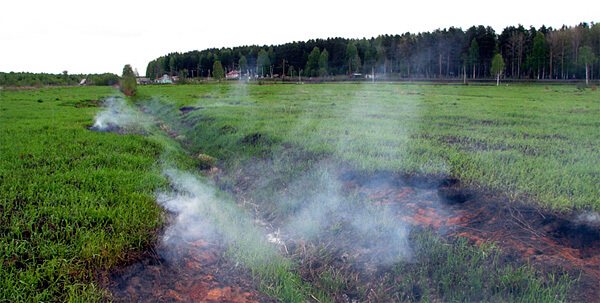
Fire on a peat bog.
Among other things, in each country and even region there may be bills, different from similar ones in other territories, prohibiting, at a certain period, lighting open fires in forest or steppe zones or in certain areas thereof. As a rule, burning fires is prohibited in the territories of nature reserves, regardless of the region.
Therefore, before going on a hike or going on a picnic with barbecue, it is advisable to ask the forestry department or other authorities related to environmental protection, where it is allowed to burn fires in a particular area.
Of course, such laws are of the utmost importance for a person surviving in the wild, but for a tourist, fisherman and hunter they will save their finances and nerves. Also, before a hiking trip, you should definitely familiarize yourself with them and find out where you can and where you can’t light fires on the planned route.
From all of the above, we can draw conclusions about the optimal place for a fire, which are easier to navigate when planning to start a fire in the wild.
Requirements
If someone is going to start a fire in the forest during a non-fire dangerous period, he must know and comply with certain safety requirements (measures):
On this topic ▼
How to prevent a fire in the forest
- The choice of location for the camp hearth depends on the availability of natural shelter from rain and wind. It may be a rock, but in no case the crowns of trees. It is advisable that there is a pond near the fireplace, and the fireplace itself is 15-20 m away from the edge of the forest. The ideal place is a sandy spit of a river.
- The following fire safety measures when making a fire in the forest recommend that there are no risk factors nearby such as dead wood and dry grass, in large quantities this is the danger of fallen trees, newly emerged young trees, accumulations of debris between stones, as well as huts, awnings, tents.
- Tourist accommodation points should be located no closer than 3 m from the fire, on the windward side.
- To avoid a peat fire (and simply spread the fire), it is better to remove the top layer of turf from an area slightly larger than the intended fire (from 30 to 40 cm in each direction). If it turns out that the chosen location has peaty, swampy soils, even dried ones, it is better to look for another place. Peat fires do not appear immediately and can continue for decades deep in the ground.
- When a fire is lit in the snow, a thin layer of snow is cleared, a deep layer is trampled down, and it is not forbidden to make a flooring from wet logs.
- A proper fire depends on properly collected fuel. The main thing you need for a fireplace in your camp is the ability to warm and cook without forcing you to hide from heavy smoke. This is exactly the heat that dry firewood from deciduous trees such as oak and birch gives.
- Experienced fishermen and hunters, knowing that healthy trees are not allowed to be cut down in young forests, bring fuel with them.
- Dry brushwood will burn quickly and will not provide enough calories for cooking. In places with sparse vegetation in the form of trees, you can use dry grass twisted into bundles, dried droppings, peat, and animal fat for hunting as fuel.
- If there is a river nearby, you can collect driftwood. If you are in the desert, any shrubs will do.
- The larger the fire, the more fuel will be required. And if there is not enough firewood, you should think in advance about the size of the fireplace; a fire with a height of 30-40 cm is sufficient for preparing tea and food.
- Fuel is collected in advance, and not when the fire has already been lit. Keep the collected firewood dry, cover it with bark, pine needles, and polyethylene.
- Wet, rotten pieces of trees are placed in the fire only when it is necessary to signal for help with thick, abundant smoke.
Fire regulations in the Russian Federation
- It is prohibited to make fires on public lands of settlements, as well as to burn garbage, grass, leaves and other waste, materials or products, except in places and (or) methods established by local government bodies of settlements and urban districts (clause 74 of the Rules) .
- It is not allowed to burn waste and containers, or make fires in places located at a distance of less than 50 meters from objects of protection (clause 77 of the Rules).
- It is prohibited to use fire distances between buildings, structures and structures for lighting fires and burning waste and containers (clause 74 of the Rules).
- It is prohibited to burn dry grassy vegetation, make fires, burn brushwood, logging residues and flammable materials within the boundaries of the right of way and roadside strips of highways, within the boundaries of the right of way and security zones of railways, overpasses and product pipelines (p. 283 of the Rules).
- It is prohibited to burn dry herbaceous vegetation, stubble, crop residues (except for rice straw) on agricultural lands and reserve lands, and to make fires in the fields (clause 218 of the Rules).
The use of open fire and the lighting of fires on agricultural lands and reserve lands can be carried out subject to compliance with the fire safety requirements established by these Rules, as well as the regulatory legal acts of the Ministry of Emergency Situations of Russia and the Ministry of Agriculture of the Russian Federation.
For additional information, see Order of the Ministry of Emergency Situations of Russia dated January 26, 2020 N 26 “On approval of the Procedure for using open fire and making fires on agricultural lands and reserve lands.”
We remind you that when a special fire regime is introduced, a decision of state authorities or local governments in the relevant territories may establish a complete ban on the lighting of fires.
How to choose a place for a fire in the parking lot and in the camp?
For a comfortable and safe holiday, you can choose a place for a fire, guided by the following rules:
- The fire should be lit away from trees. Compliance with this rule will protect the forest from fire, and the tourist from fines and burns. Among other things, if you light a fire in a winter forest under trees, water from melted snow may flow from them into the fire, or it may happen that a whole lump of snow falls from a spruce branch into the fire, extinguishing it;
- A safe place is a flat rocky area, located away from dry vegetation, such as reeds;
- If there is a body of water near the camp (tourists usually try to camp in such places), this is very good: in this case the water can be used both to extinguish the fire itself and to extinguish a fire if one suddenly arises;
- It is advisable to choose a dry area for the fire. If this is not done, it will be more difficult to start a fire due to the moisture entering it with the air;
- It is advisable that there is a natural wind barrier near the site, for example, a rock or a large fallen tree. Such a “wall” will not only protect the fire from the wind, but also serve as a screen that reflects infrared radiation from the fire onto people and additionally warms them;
- If there is already an old fire pit near the chosen place - a place where a fire has already been burned, or a specially equipped place for making a fire made of brick or other materials, then it is better to burn a fire on it, unless this place does not contradict the basic rules of fire safety. This will reduce the harmful impact on nature and reduce the likelihood of a fire;
- The size of the fire pit and the distance from it to the tent should be chosen based on the size and type of the fire itself, as well as whether “shooting” wood will be used or not. Usually, from most fires, for example, from a hut and taiga, it is enough to put up tents at a distance of 3-5 meters, but if you plan to spend the winter night in a lean-to hut with heating from a node, then the distance here needs to be selected experimentally, otherwise the heat will not be enough for warming the body. The heating zone here depends both on the air temperature and on the quality of the screen arrangement for heat;
- The tent should be positioned in relation to the fire so that the wind carries sparks and smoke in the opposite direction. However, if you spend the night by the fire, the hut must be built near the node so that the wind blows from the side.
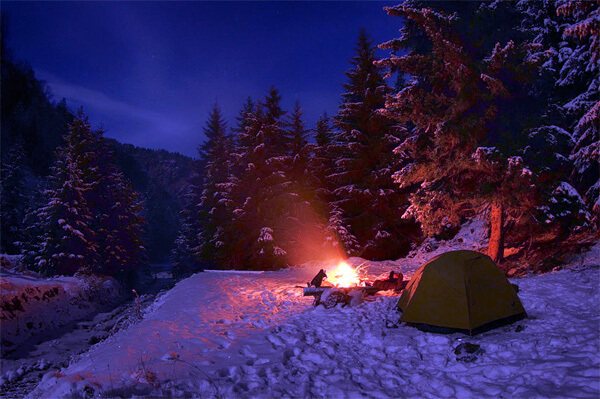
Another well-chosen place for a fire is on a high river bank, away from trees and in shallow snow.
Now let’s look at how to choose and arrange a place for a fire in difficult conditions.
When silence is joy
It is not at all surprising that often gatherings by the fire can take place in absolute silence, which does not irritate, but, on the contrary, calms. The atmosphere of such cozy moments absorbs us with its mystery: as if plunging into some kind of trance, we listen to the crackling of the fire and watch the clouds of smoke that rise above the fire, rushing into the evening sky. Romance, isn't it?
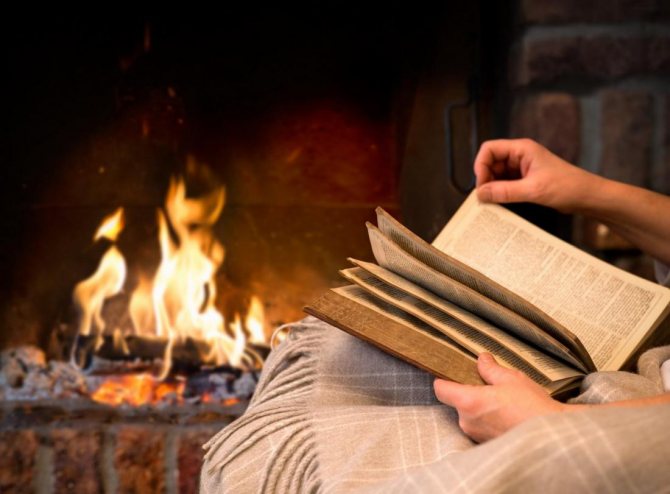
Preparing a fire pit in deep snow
If we consider the situation in a winter snow-covered forest, then most fires, without preliminary preparation of the place for their lighting, will melt the snow and go to depth. In this case, the water from the melted snow will moisten the fire, and the resulting hole will reduce the access of oxygen, which can negatively affect combustion. Well, of course, a fire buried under the snow can no longer be considered as a source of heating, and cooking food on it, located 1.5 meters below the snow level, is also somehow not very convenient.
To avoid these inconveniences, there are several solutions:
- Excavate the fire pit down to the ground and expand it. This option is convenient for cooking and heating during the day in between other activities around the camp when there is a small layer of snow cover.
- If the depth of the snow cover is great (tested with a long straight stick stuck into the snow to the ground) and digging is impractical, you can make a deck for many fires from thick logs. This flooring should be wider than the fire itself. In this case, even if the fire melts the snow, it will only be in the central part, while the edges of the flooring will remain in the unheated areas, keeping the burning wood on the surface.
- Use types of fires that do not melt snow. For example, you can make a wooden primus stove with your own hands for cooking or a node from two logs for a comfortable overnight stay, and a taiga fire will help you both cook food and keep warm without making any special efforts.
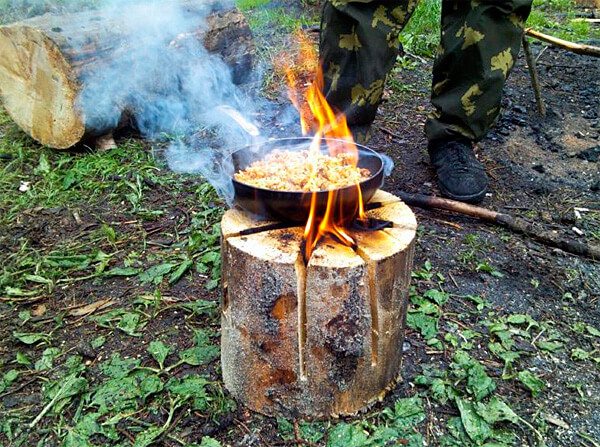
The Finnish candle is a fire that requires very little space and does not fall into the snow.
If you plan to make a fire just to boil a mug of tea, then you can light it on a floor made of brushwood or pieces of tree bark. Such a fire will cope with its task before going into the depths.
Preparing a site for a fire in swampy areas and on water
In swampy areas, if you do not have a fire pit, starting a fire can be difficult.
To protect the fire from water, it can be done on the flooring. For this:
- Three spears break off. You can take four, but this is an extra waste of time. Horns are stuck into the bottom of the reservoir so that their “horns” rise above the water. If you look at the structure from above, the spears should be located in the shape of an equilateral triangle. When using four spears, a square should form.
- On three slingshots, two poles are placed in the gap between the “horns” so that on one of them the ends of two poles lie simultaneously, while on the other two slingshots - on one end of the other poles.
- A flooring of thin logs is placed on top of the poles, which it is advisable to cover with earth so that the logs do not quickly burn out. If there is no dry earth, and you plan to burn the fire later, you can spread a thick layer of dirt on the flooring: by the time the fire is lit, it will have time to drain a little and dry out. That's it - the fire pit is ready.
Also, for the same purposes, you can make a small raft and similarly cover it with a layer of earth that protects the structural elements from burning.
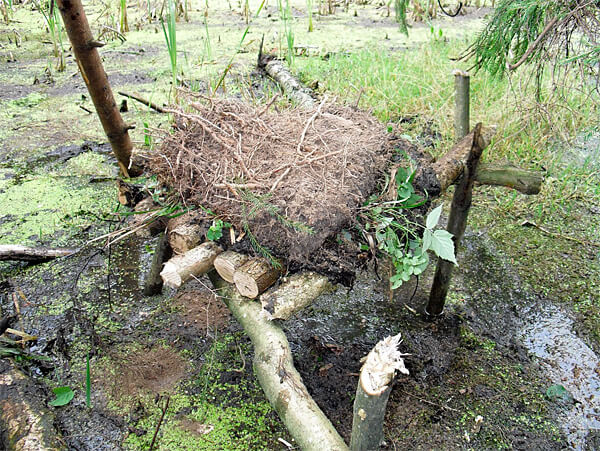
Fire pit in the middle of a swamp.
I know of other ways to protect fire from water, but they are either more complex or require additional materials that are not always at hand, so I see no point in talking about them.
Drying clothes and shoes near the fire
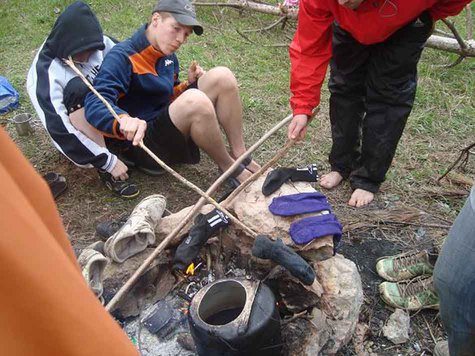
To dry clothes, it is advisable to provide special “hangers” consisting of 2-3 slingshot stakes driven into the ground with transverse poles placed in them or ropes stretched parallel to the fire pit. They should not be located above the flame, but at some distance from it. The temperature in the drying zone should not exceed 45-60°C, otherwise clothes may lose their original strength, and synthetic clothes may melt.
Strong heat does not so much dry things out as spoil them! The easiest way to check the temperature is by placing your face or hand in the drying area. If your skin is hot, it means that the heating is excessive and it is better to move the “dryer” further away from the fire.
At small rest stops, when there is no time to build capital reflective canopies, they can be made from wet outerwear, thereby combining the pleasant thing - warming your own frozen bodies with the useful thing - drying clothes. To do this, a rope is passed through the sleeves of jackets, raincoats, etc., which is then stretched parallel to the fire pit behind the backs of the people sitting near the fire.
Instead of a rope, you can use a long pole laid on the branches of nearby trees, or “hangers” - stakes driven into the ground, to which transverse sticks are tied, inserted into the sleeves.
Before drying, shoes should be unlaced, straightened, and if they do not hold their shape, stretch the tops to the sides using small sticks inserted inside. Then the boots should be laid sideways on a dry stone placed under them, hung on branches stuck into the ground, or tied over a fire using ropes. Just be sure to make them cotton, which are not afraid of fire. And be sure to move it away from the fire.
Most inexperienced travelers do the opposite, i.e., wanting to get a quick result, they try to shove their wet boots almost into the fire. As a result, excessive spot overheating leads to the leather on shoes warping and cracking, felt boots “drying out,” and synthetic coatings can simply melt.
By the way, I once had to travel in boots that were “shrinked” by fire and therefore lost their shape and shrank by three sizes. And I had to see how my artificial fabric socks turned into hot synthetic streams and drops flowing from the fire pit. The criterion for drying shoes should be the heating of the surface of the shoe, which should not exceed 40-45 ° C. That is, when touched, the skin of the fingers should not feel hot.
Andrey Ilyin January 30, 2012 at 00:08
How to protect a fire from the wind
Often, the wind helps to fan the fire and make it burn better, but it can also create some difficulties, for example, for cooking. Thus, in a strong wind, the flames can be blown away from the pot suspended over the fire, which leads to large expenditures of fuel, time and effort for cooking.
In this and other cases, when the influence of the wind needs to be reduced, you can create a wind barrier from available materials, for example, drive four sticks into the ground, between which lay branches cleared of leaves, or weave the sticks with thin brush according to the principle of weaving a basket. In permanent parking, the cracks in such a fence can be covered with clay if necessary.
Also suitable for these purposes is one of the types of fire in a pit, for example, a trench or a Dakota hearth, in which a wind barrier is provided by the design of the fire itself.
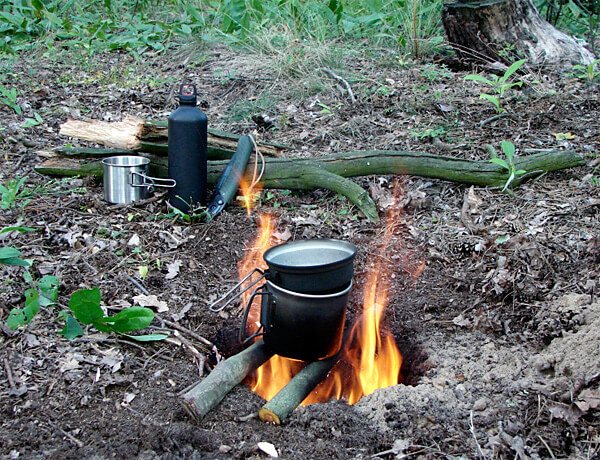
The Dakota hearth is a fire that is not afraid of the wind.
Well, and of course, natural shelter can be used as a wind barrier, as discussed in the rules for choosing the optimal place for a fire. In this case, the location of the fire is initially selected taking into account the direction of the wind.
Methodical manual “Starting and extinguishing a fire”
Municipal autonomous institution of additional education
"Children and Youth Center of the Kirensky District "Harmony"
"Starting and putting out a fire"
Compiled by:
Zhitov Igor Mikhailovich – teacher
additional education Municipal autonomous institution of additional education
"Children and Youth Center of the Kirensky District "Harmony"
Kirensk, 2020
Subject:
Properly build and extinguish a fire
Target:
Introduce children to fire safety rules in the forest.
Tasks:
- Give basic concepts of fire safety rules.
- Find out what practical experience children have in making and putting out fires.
- Foster a caring attitude towards nature.
Literature: “Fire safety rules in forests”
E.A. Shchetinsky “Extinguishing forest fires”
Equipment:
- Posters
- Scheme - classification of fires.
- Photos of the consequences of forest fires.
- Axe, shovel, matches, bucket, firewood
Lesson plan:
- Causes of forest fires
- Choosing a place to make a fire
- Procedure for making a fire
- Setting up a fire pit
- Making a fire
- Putting out the fire
Progress of the lesson
In our opinion, on average, 57 percent of forest fires arise from improperly lit and unextinguished fires, as well as burning of ground cover, 14 percent from lightning, 10 percent from violation of the rules for operating machines with internal combustion engines, 7 percent from children playing pranks with fire , 5 percent - from smoking while driving and in unequipped places, 4 percent - due to the use of wads made from smoldering materials, 3 - from unknown reasons.
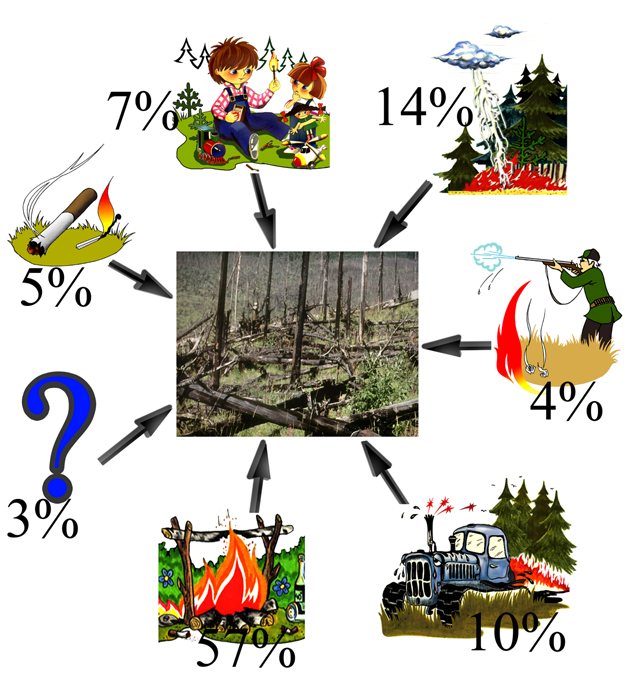
In order to prevent fires in the forest caused by people, it is prohibited:
- light fires in young coniferous forests or in close proximity to them, in old burnt areas, in areas of damaged and withered forest, on peat bogs, in cutting areas with logging residues and harvested wood left, under tree crowns, in places with dried grass (spring, autumn ), green mosses (summer, autumn), lichens during any period of the fire season;
- use fires in the forest without taking measures to prevent their spread;
- leave the fire unattended, even for a short time, and, when leaving, leave the fire burning or smoldering;
- burn dry grass in the forest, in forest clearings, clearings, meadows and stubble in clearings.
To prevent a forest fire, it is better to light fires in specially prepared places or on a sandy, rocky spit near a river or stream, on a mineralized roadside strip away from the forest wall.

In other places, especially during drought, a place for a fire must be prepared by arranging a mineralized strip around it, at least 0.5 meters wide.
Making a Fire
"Fuel for the Fire"
Even the most urgent fire should burn unattended for 5-8 minutes, no less. Until you bring a new portion of firewood. Otherwise, you will have to start all over again. The criterion is the following: reliable burning of a stick as thick as a human finger.
Trying to light a fire with gasoline (diesel) can cause burns. By the way, wet firewood will never catch fire from gasoline, so starting a fire with gasoline only brings danger and no other effects.
"Firewood preparation"
Dry firewood can be obtained by breaking off the lower branches. Don't forget about safety measures. A heavy twig falling on your head is a serious danger!
The easiest way to prepare dry wood is to lean on your body - strength aches! But this is for a tree no more than 5-10 cm thick. You can rock the tree and sooner or later it will fall (!?). But... the top may fall off a little earlier, and... will you have time to rebound? Especially in deep snow?
The simplest method is a “fishing rod” made from a long thin pole, finally, to which a loop is tied from a scrap material. The loop can be made, for example, from trousers. Belts and scarves, as experience shows, do not justify themselves - they lack strength.
Having hooked the “fishing rod” onto a twig, you can gently rock the dry tree into resonance, the pole will serve as a lever, and... it’s yours. Better yet, hook your “fishing rod” to the tree trunk itself.
Of course, far from it, not every tree can be felled like that. Selection criterion: shake your favorite “dry land” slightly with your hands; if there is any swaying, you can throw it down. The tree is prepared for you! This way you can search for dry wood even in pitch darkness. Thus, you cannot shake a living tree.
Many complications arise when trying to break a relatively thick dry stick. For women's hands, for example, already 3-4 cm thick - maybe already beyond their strength.
But the usual methods - “over the knee” or with a kick - are far from the only ones. A dry trunk can be wedged between trees and, relying on this improvised system of levers, the “far” end can be broken off. However, this method is for long poles.
A short, thick stick can be broken by hitting it against a tree or a stone. However, there is one subtlety in this technique, without which the technique rarely leads to success. Moreover, if you hold a dry stick (sushina) in your hands, you can feel a sharp, long-lasting pain.
The subtlety is this: before striking, you need to find the center of gravity of the dry log. And this is precisely the place to strike. In this case, Sushina “breaks herself.” In practice, even 12-year-old girls provide wood for the fire in this way, without an ax or saw.
"Base for the fire"
Let's get back to the basic principle. You would never place a newborn on cold ground. That is why, under the preparation for the fire, you will definitely make a bedding - a platform of tightly folded logs. Otherwise, the cold, moist air evaporating from below will simply extinguish your still weak fire at the very beginning.
Moreover, if there is wind, the platform can easily be turned into a “cradle”. The “cradle” can be improved by removing the raw bark. And also - if there are stones, “crush” the top layer of wood with stones - you can make the “cradle” dry, “soft and fluffy”.
"Shape of a Fire"
For a newly born baby, the optimal shape is a “tent”. But, putting together a tent from thin branches, and even with frozen, stiff fingers, is quite a difficult task.
If the base of the fire is folded into a “cradle”, then two long thin sticks placed on the edges, and on their crosshairs, the “tent” is folded up simply...
And when the tent fire “comes into force”, and your small group (maybe only you and the Bonfire) increases by a whole, independent participant; then you can also entrust him with independent work: to turn, depending on the circumstances, into the necessary fire of a certain type: “well”, “node”, “star” and so on...
While using the fire, you must constantly monitor its condition. At the end of use, you need to turn the unburned logs upside down with coals, cover them with earth, ashes from the fire, or fill them with water.
It is dangerous to throw a burning match or a smoldering cigarette butt onto the ground cover with dry flammable materials. In hot weather and wind, they will certainly cause ignition of the ground cover and the outbreak of a forest fire.
It is especially important to follow the stated rules during periods of long droughts and when special forest protection signs are installed in the forest.
How to put out a fire!?
A fire in the forest during the snowless period must be extinguished in any case, even in damp weather and rain, to be sure that the fire will not hide in the litter, in some piece of wood or dry rot.
Such actions should become a habit - you need to know for sure that you have done everything to prevent a fire. Remember, you should never leave a fire unattended; even a slight breeze can cause the fire to spread quickly.
Always have water on hand and a shovel ready so you can immediately deal with any escaping flames.
To put out a fire with water.
- Fill the fire with water. Water can be brought with items you have on hand (plastic bags, glass and tin cans, etc.)
- Mix the fire well with a shovel (if you don’t have a shovel, you can use an axe, a sharpened damp stick, etc.). Do not forget to move all the stones, large firebrands, burnt remains of logs - there may be coals under them - fill them with additional water.
- Fill the fire with water again.
- Check the coals and ashes - they should be cold.
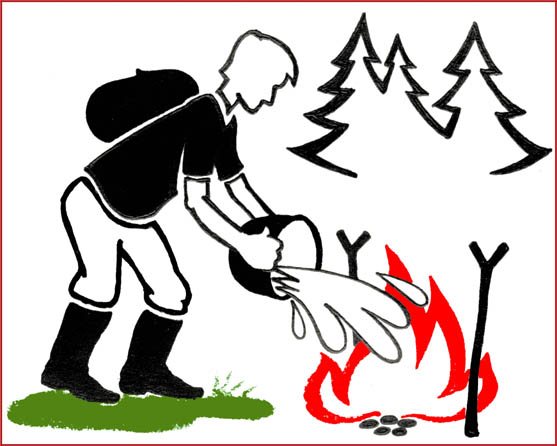
To put out a fire without water.
- Put out the flames, dismantle the fire, stir up the coals and firebrands.
- Stir with a shovel or other available tool and dig around the fire in a circle.
- Cover the fire with a thick layer of soil, be sure to take it from a depth of at least 30 cm, preferably wet.
- Thoroughly trample the layer of earth on the fire until it stops smoking.
- Large smoldering firebrands (remnants of charred firewood) can be buried separately in a hole to a depth of at least 30 cm.
- Do not immediately leave the fireplace; make sure that after 15-20 minutes it does not start smoking again.
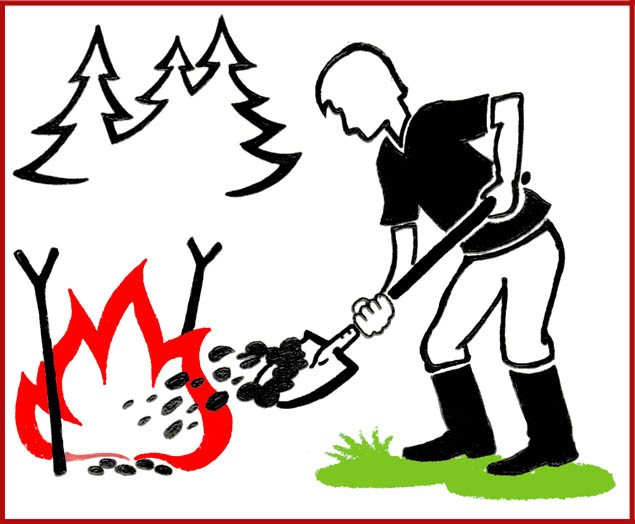
How to protect a fire from precipitation
It should be noted that some types of fires themselves are not afraid of minor short-term precipitation. These include, for example, nodya, Finnish candle or Dakota hearth. The last two can easily withstand drizzling rain, being covered with a flat stone or a dish in which food is cooked. But with heavy rain or snowfall, even they can go out, so knowing how to protect the fire from getting wet is still useful.
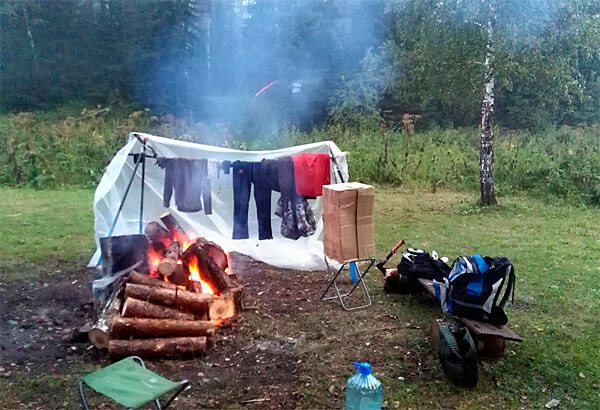
A big fire that burns safely in the rain.
Most often, for these purposes, they use an awning or canopy made from scrap materials - spruce branches, for example. In some cases, it is possible to find natural shelter, for example, a large boulder, under which you can sit with a fire.
You can organize a place for a fire in a cave, but this is not always convenient: the fire has to be lit at the entrance, which makes it difficult to freely enter and exit the cave, especially with a narrow passage. If you light a fire inside the cave itself, you can be poisoned by the combustion products of the fuel.
Despite the popular belief that our ancestors lived in caves, in fact, this way of life was not typical for them: caves are damp, dark, and lighting a fire inside will cause more harm than the benefits that can be gained from such actions. Ancient people sometimes used caves as temporary shelters, but overall the "caveman" is more of a literary trope than an actual milestone in human history.
Release your pain
Being around a fire allows us to be more vulnerable. All our masks fall off at this moment. If in real life we try to keep up the brand, then in this case we allow ourselves to relax. By the way, this is also useful for our immunity: sometimes, simply letting go of the situation, accepting it as it is, we get rid of fears, complexes, and uncertainty. It’s okay if you suddenly feel inexplicably sad near the fire. It’s better to throw out all your emotions in this cozy corner. The crackling fire will be your best accompaniment. You will not notice how you will open up to another person. You don’t have to feel guilty for being too frank, because this atmosphere is conducive to just this kind of explanation, pouring out your soul.
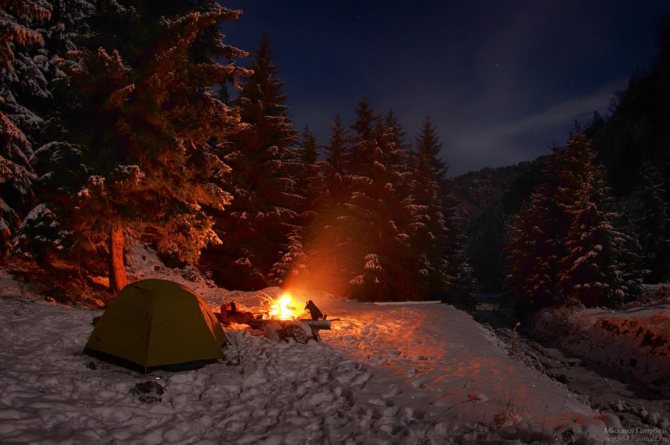
If the person who is next to you also appreciates such a pastime, you will have multiple trips together, full of romantic idyll.
Found a violation? Report content
How to hide the place where the fire was burning?
Many people do not care about maintaining their camp site in the same condition as when they started organizing the camp. But this rule is a sign of good manners among tourists, and in some cases a necessity, for example, when the task is to hide the place where the camp was located.
To ensure that there is no fire left from the fire, you can:
- Make fires that do not leave a fire pit, for example, a Finnish candle or one of the options for a fire in a pit.
- Light a fire on a log deck or on a platform made of stones. After this, the cooled logs and stones can be hidden in dense thickets, or they can be left for others.
- Light a fire near a pond when the water level in it drops so that the rising water washes away traces of the fire.
- Light a fire in special camp stoves, wood chippers, or use burners and dry fuel with a special stand for it.
If it is necessary to hide the place where the fire burned after the fact, it can be covered with earth, covered with leaves, or the turf can be replaced with a similar one dug in another place.
Fine for lighting a fire in the wrong place
According to fire safety rules approved on June 30, 2007, it is not possible to light fires everywhere. For example, in the territory of young coniferous trees, in peat bogs, in places where there are accumulations of freshly cut trees that have not been cleared of wood residues, as well as in the presence of dry grass in the immediate vicinity. The territories of nature reserves are also places where lighting fires is strictly prohibited.
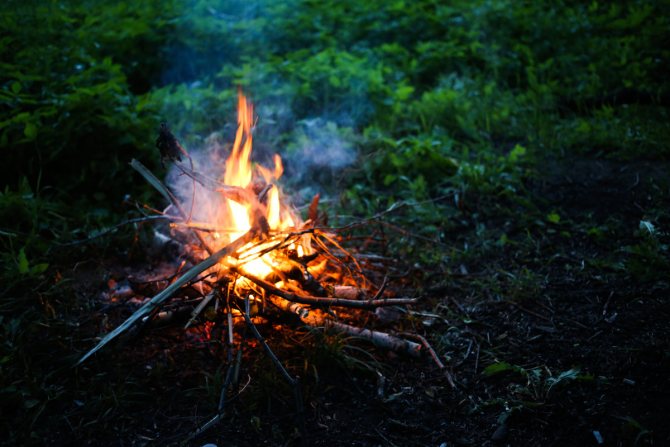
If fire safety rules are not followed:
- individuals - from 1500 to 3 thousand rubles;
- officials - from 10 thousand to 20 thousand rubles;
- legal entities - from 50 thousand to 200 thousand rubles.
In the event that a violation of fire safety rules has resulted in significant damage to the environment, fines will be calculated in the following amounts:
- individuals - from 3 thousand to 4 thousand rubles;
- officials - from 15 thousand to 25 thousand rubles;
- legal entities - from 150 thousand to 250 thousand rubles.
There is such a thing as a special fire regime. It is installed during periods of elevated air temperatures, when spontaneous combustion of dry trees in wooded areas is possible. For lighting a fire during this mode, the penalties are as follows:
- individuals - from 4 thousand to 5 thousand rubles;
- officials - from 20 thousand to 40 thousand rubles
- legal entities - from 300 thousand to 500 thousand rubles.
If, due to negligence after lighting a fire, the damage caused to the environment is characterized by significant loss of vegetation, the fines will vary in the following ranges:
- individuals - 5 thousand rubles;
- officials - 50 thousand rubles;
- legal entities - from 500 thousand to 1 million rubles.
0
Author of the publication
offline 2 years
Nika
7
I am interested in hiking and traveling, photography and videography. I have been going hiking since childhood. The whole family went and went - sometimes to the sea, then to the river, to the lake, to the forest. There was a time when we spent a whole month in the forest. We lived in tents and cooked over fires. This is probably why I am still drawn to the forest and, in general, to nature. I travel regularly. About three trips a year for 10-15 days and many 2 and 3 day hikes.
Comments: 0Publications: 668Registration: 10/23/2018
Nika Fire, warmth
How to heat a tent from a fire?
Sometimes beginners try to make a fire right next to the tent to keep warm at night. However, this threatens the tent with holes from sparks falling on it, and in some cases, fire.
For the same reason, you should not light a fire inside a tent or marquee, even when using special flooring: if the tent does not burn, then the person will certainly inhale the products of fuel combustion, including deadly carbon monoxide (carbon monoxide). Likewise, an open fire should not be lit in an igloo. In such shelters, you can only use special stoves or burners, the smoke from which is discharged outside the shelter.
If you still need to light a fire inside a shelter, then a wigwam is best suited for these purposes. Thanks to its conical shape and the hole in the upper central part, the products of fuel combustion are effectively removed to the outside, and the walls of the shelter itself serve as a “screen” that reflects the heat of the fire onto the people in the shelter.
Attention!
Burning a fire and even candles in closed shelters with poor ventilation is dangerous to life: the resulting carbon monoxide can kill a sleeping person who was unable to sense the illness in time.
I still consider the measures described to be extreme, more suitable for a survival situation rather than a hiking trip, because for a tourist who plans his outing into nature in advance, it is easier to prevent a nuisance than to deal with it later, and for this purpose it is worth buying or borrowing a good sleeping bag for hiking season and a water bag that can prevent not only your sleeping bag, but also other things from getting wet. With proper preparation for a hike, heating the tent from a fire is not required at all.
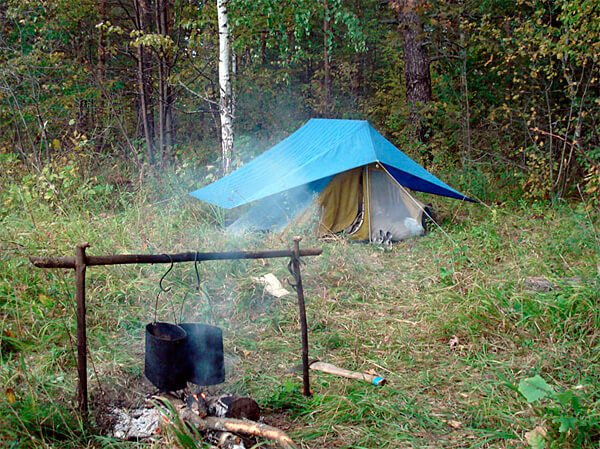
A good location for the tent relative to the fire is far enough away so that the fire does not pose a threat to shelter, but it is not difficult to approach it.
As you can see, choosing a place for a fire and its proper organization are no less important than choosing the fire itself.
This knowledge will help not only to avoid troubles in the form of a fire going out or forest fires, but also to reduce the likelihood of paying a fine provided by law for lighting a fire in the wrong place.
Methods for making a fire
The first thing you need to start making a fire is lighting the kindling. Any material that produces a strong short-term flame during combustion that can ignite the main combustible component can be used. It can be paper or dry birch bark. Less commonly, dry spruce, moss or wood shavings are used for this purpose.
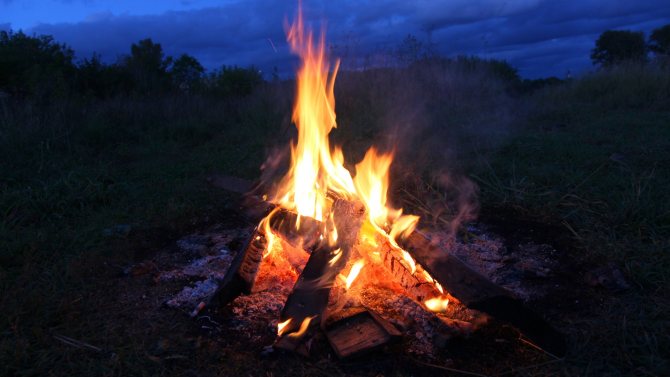
The kindling is laid as a kind of substrate. Thin dry branches are placed on top of it in a pyramid. In order for the kindling to burn completely, it should be lit from below. To do this, use either long tourist matches or a gasoline lighter, which ignites a piece of paper rolled into a tube or a thin splinter. Using both options helps avoid getting burned during ignition.
As soon as the top layer of firewood flares up, thicker branches are thrown into the fire, then even thicker ones. In this way, the volume of combustible material gradually increases until the main prepared firewood is used. The fire will be considered lit when hot embers begin to form. Before this happens, there is a risk that the fire will go out.
In wet weather
It often happens that you have to make a fire in the rain. To succeed, you need to take care in advance about kindling, which you can take from home, and about sealing matches. If you have a non-wet box in reserve, this will significantly speed up the ignition process. To keep matches dry even after contact with water. They can be dipped in paraffin.
Or, for example, place a box of matches in a metal package, and fill the joints and seams with sealing wax.
Among the types of kindling, dry alcohol tablets, celluloid (old photographic film) or a paraffin candle may be suitable. The latter is especially popular due to the versatility of the material (for example, treating shoes so that they do not get wet), and it is easy to find in any store.
Until the fire flares up, it is better to organize temporary cover. For example, ask your partner to hold the tent on top. In order to obtain a suitable flame, thin branches must be dried using the fire from the kindling. If thicker firewood turns out to be damp, which is quite logical in damp conditions, you can use a knife to trim the bark, but not separate it from the main trunk at all. That is, the end result should be a log with curls on one side. The bark dries faster, and by burning it helps the log itself become drier.
The shape of the stacked firewood should resemble a pyramid or hut. Thus, when water hits them, it will flow down and will rarely be able to reach the main flame.
